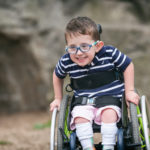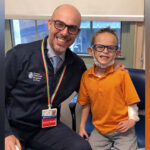Lifechanging surgery brings Ann-Raleigh relief from VUR — and some new ‘besties’

When Ann-Raleigh Murthy travels to Boston from her home in Louisiana, she has a list of “must-dos.” Among the highlights: Ride the swan boats in the Public Garden, swing by her favorite chocolate shop, go shopping — and visit with Dr. Carlos Estrada, Boston Children’s urologist-in-chief. Dr. Estrada, along with neurosurgeon Dr. Benjamin Warf, “are two of my besties,” says the 11-year-old.
Ann-Raleigh has been seeing both doctors since before she can even remember. Born with spina bifida, she also had hydrocephalus, a build-up of cerebrospinal fluid in or around the brain. Although Ann-Raleigh’s local hospital recommended placing a shunt in her brain to drain the fluid, her parents hoped for an alternative. “We had heard that Boston Children’s offered other options, so we made an appointment with Dr. Warf,” says her mom, Heddie.
Dr. Warf had pioneered the combined endoscopic third ventriculostomy and choroid plexus cauterization procedure (ETV/CPC), a treatment that can successfully prevent the need for a shunt in many children. Ann-Raleigh was a candidate and underwent the procedure when she was 15 months old.

Finally finding answers
Impressed with the experience, Ann-Raleigh’s family soon decided to transfer all of her spina bifida-related care to Boston Children’s Spina Bifida and Spinal Cord Conditions Center. In addition to treating the hydrocephalus, they hoped that the care team would be able to help address Ann-Raleigh’s recurrent urinary tract infections (UTIs). She had been hospitalized in Louisiana on and off since she was just 4 months old, but the problem continued. “It was hard for a child that young to explain what was wrong and what hurt,” says Heddie.
She decided to get a second opinion from Dr. Estrada. While repeated urodynamics testing at their local hospital hadn’t revealed a cause of the UTIs, Dr. Estrada and his team were able to diagnose Ann-Raleigh with vesicoureteral reflux (VUR) using the same test. In this condition, urine moves backward into the ureters and kidneys, which can lead to recurrent UTIs.
“Before, it felt like a guessing game,” Heddie says. “Getting to Boston Children’s was a huge relief. Now, we finally feel like we have answers.”

‘A whole new ball game’
When Ann-Raleigh was about 2, Dr. Estrada performed a bilateral urethral implantation, a surgical procedure that reconstructs the connection between the bladder and ureters to prevent VUR. Along with preventive antibiotics and the use of intermittent catheterization, the procedure has helped keep UTIs at bay.
In addition to traveling, Ann-Raleigh enjoys cheerleading, skiing, making art, and reading graphic novels. When she returns to Boston for follow-up visits, she and her family appreciate the ability to see multiple Boston Children’s experts during one appointment, helping them streamline care — and she never misses the opportunity to say ‘hi’ to Dr. Estrada and the rest of the team. Thanks to the care she’s received from them, life now, says her mom, “is a whole new ball game.”
Learn more about the Department of Urology or make an appointment.
Related Posts :
-

Another level of gratitude: Spina bifida care for Liam
Most parents first walk through the doors of Boston Children’s Hospital seeking answers about their child’s health. But ...
-

On her own terms: Robot-assisted procedure gives Sage more independence
At 19, Sage Nault has had multiple surgeries, aimed at addressing challenges related to myelomeningocele, the most severe form of spina ...
-

Building a better bladder: Reconstructive urologic surgery helps Mikey thrive
When Mikey Tibbetts’ parents, Johanna and Matt, take him trick-or-treating, the process can last for hours. “He knows everyone and ...
-

Predicting the best treatment for vesicoureteral reflux in kids: The power of machine learning
The result of abnormal formation of the normal valve between the kidney and bladder, vesicoureteral reflux (VUR) can lead to ...





